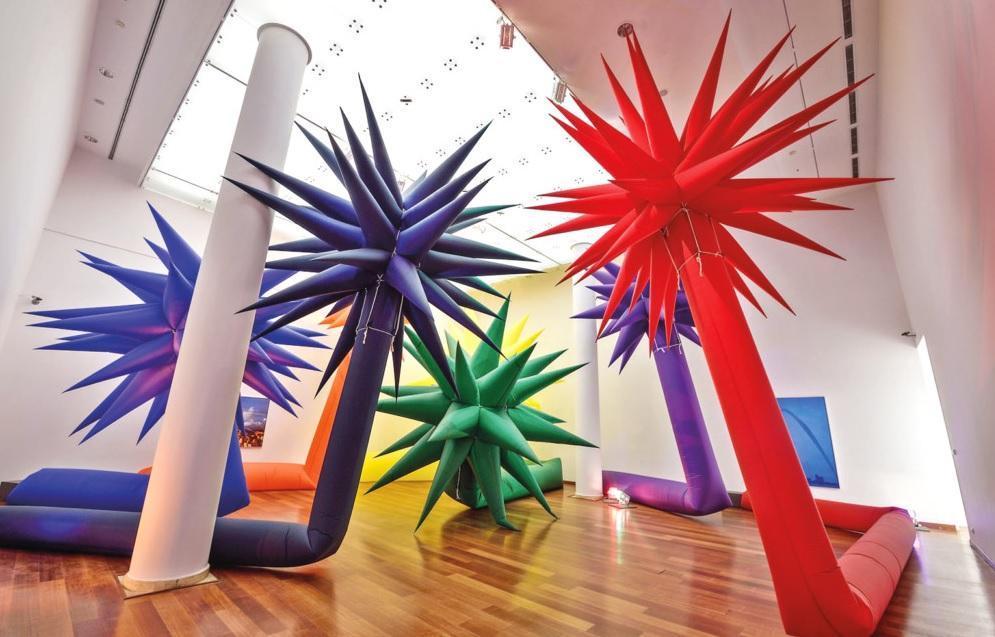
Sabancı University Sakıp Sabancı Museum’s (SSM) exhibition “ZERO. Countdown to the Future,” which drew global attention back in 2015, is now online to meet art enthusiasts, shedding light once again on the ZERO movement.
The exhibition was earlier realized from Sept. 2, 2015, until Jan. 10, 2016, in joint efforts with Akbank Sanat.
Born in the aftermath of the Second World War, ZERO received its name from the countdown until the launch of a rocket and soon became one of the major avant-garde movements of the mid-20th century.
Drawing upon digitalSSM’s sources, the online version of the exhibition provides viewers with a thematic framework and presents ZERO artworks through an arrangement based on the elements of fire, color, vibration, light, shadow and space.
Nazan Ölçer, the director of SSM, said: “The ZERO movement was born after the Second World War thanks to the efforts of a handful of young artists, bringing hope and offering the world a bright future. This is exactly what we need today in the times we are passing through: namely hope and freedom from anxiety.”
Stating that throughout history, art always proved to be an important means in coping with issues like war and epidemics, all problems affecting the world on a global scale, Ölçer said, “During such times, many great artworks were created to express the suffering of humankind and to express the hope that similar experience may never repeat itself.”
“The yearning for going back to point zero, and start afresh, will be with us also in the future, as it was in the past,” he added.
Noting that undoubtedly, the impact of the COVID-19 pandemic, which has brought the whole world to a standstill, will be observed in many areas in the future, Ölçer said: “The ZERO movement has made it possible for art to keep abreast with all the bewildering developments of the time, like the emergence of brand-new technologies, like the space-race at its full speed, and like reaching the moon or even stars, which is no longer a mere dream.”
The ZERO movement first started in Germany, where the Second World War had left the deepest scars while plunging the whole of Europe into misery. German artists Otto Piene and Heinz Mack came forward with the proposal of “abandoning pessimism and starting from zero.” Another German artist Günther Uecker joined them. So, together with names like Yves Klein, Lucio Fontana and Piero Manzoni, who were forerunners of the movement, many artists from all over Europe, and even from faraway places like Japan could find a corner for themselves around the ZERO-idea.
When founder Mack announced the end of the ZERO in the last exhibition in 1967, the ZERO concept had long since stamped its mark on a period of 20th-century contemporary art, despite its lifespan of just 10 years.
The online exhibition displays artworks by Mack, Piene, Uecker, as well as artworks in different techniques by notable artists such as Klein, Manzoni and Fontana who are the pioneers of the movement.
Excerpts from the exhibition catalog, focusing on the avant-garde position of the ZERO movement in the art and political history of the 20th century, are also being offered online.
Art historian and curator Norman Rosenthal contributed to the catalog with his article on ZERO’s history. Apart from this, texts written by artists Piene, Mack, Uecker, Klein, Manzoni were also translated into Turkish for the first time to be published in this catalog. It also has the interviews conducted by Hans Ulrich Obrist with the founders of the ZERO movement: Mack, Piene and Uecker, translated into Turkish for exhibition purposes.
The online exhibition also includes children’s art exercises. Inspired by the experiments with light, as conducted by the artists themselves and the materials used by them, these exercises are meant to introduce the kids to the ZERO movement.
Also, a special pamphlet, the Dynamo gazette, prepared in reference to the magazine published by the artists between 1958 and 1961 and distributed during the exhibition, is now offered online.
The online version of the exhibition “ZERO. Countdown to the Future” can be seen on Sakıp Sabancı Museum website.